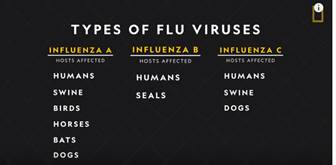
МЕТОДОЛОГИЧЕСКАЯ РАЗРАБОТКА ПО АНГЛИЙСКОМУ ЯЗЫКУ
ПО ТЕМЕ «FLU VIRUS»
Warm-up
· What do you feel when you catch a cold?
· How to recognize if it is a virus or bacteria?
· How the virus can be transmitted?
Vocabulary
|
flu |
грипп |
seal |
тюлень |
|
host |
хозяин |
defense |
защищать |
|
unleashing |
развязать |
strain |
штамм |
Read the text
The flu is a highly contagious respiratory illness. It turns up year after year with devastating consequences. All caused by a most elusive virus.
The influenza, or flu virus, is a recurring nightmare. It causes more than 36,000 deaths in the U.S. each year. And it was responsible for some of history's deadliest pandemics.
Like other viruses, the flu virus is a parasite. The viral agent itself called, a virion, is made of ribonucleic acid or RNA surrounded by proteins. The flu virus uses two proteins to attack its host, hemagglutinin (HA protein) and neuraminidase (NA protein). The HA protein attaches a virus to a cell and lets it in. Once the virus is inside, it multiplies. Then the NA protein cuts this viral swarm loose, sending it off to infect more cells. This triggers the immune system to bombard the swarm and to destroy infected tissue throughout the respiratory system. Unfortunately, this response can also inadvertently lead to death through organ failure or secondary infections like bacterial pneumonia.
The flu virus has been nearly impossible to eradicate. Largely it is due to its uncanny ability to mutate. Since just 2004, more than 5,000 different strains of the influenza virus have been sequenced. Those that affect humans are categorized as Types A, B or C.

With Type A strains being the most capable of unleashing a pandemic. Influenza A viruses mutate more rapidly allowing them to adapt to new hosts and even cross species. Avian flu and Swine flu, for instance, are two strains of Type A viruses that through mutations can be transmitted from birds and pigs to humans.
One of the deadliest flu pandemics was caused one such virus. Between 1918 and 1919, the Spanish flu infected a third of the global population and killed up to 50 million people worldwide. Called H1N1, this particular strain of virus likely came from birds.
The threat of another influenza pandemic remains. In the meantime, scientists are constantly monitoring the flu virus and developing seasonal vaccines to create our best line of defense.
URL: https://youtu.be/WSZEcpti2i0
Answer the questions
1. What is the structure of this parasite?
2. How does it attack the host?
3. What happens to the virus inside the cell?
4. Does it have the ability to mutate?
5. How many types of the viruses are there?
6. Why does type A influenza unleashing a pandemic?
7. How can we defense the flue?
Follow-up How to fight the flu?
Скачано с www.znanio.ru
Материалы на данной страницы взяты из открытых источников либо размещены пользователем в соответствии с договором-офертой сайта. Вы можете сообщить о нарушении.